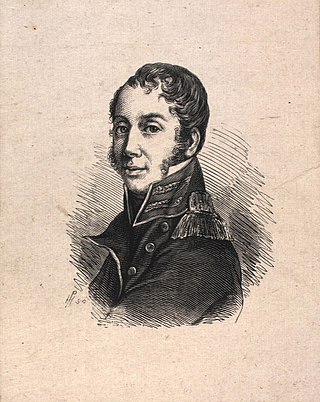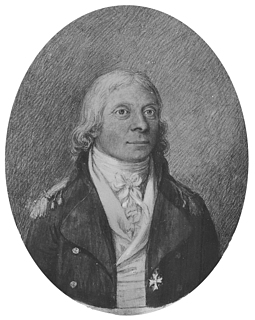Career
Wleugel became a cadet in 1749, a junior lieutenant in 1755, a senior lieutenant in 1758, captain lieutenant in 1763, captain in 1769, commander captain in 1781, commodore in 1789, counter admiral in 1796, vice admiral in 1800 and admiral in 1812. [1]
In 1751–54, he was in India with the frigate Bornholm. In 1758, he was in Marocco with the frigate Hvide Ørn. In 1759, with the frigate Grønland, he escorted a convoy to St. Martin. In 1760, he was in the Mediterranean Sea with Fyen. [1]
In 1764, he studied water infrastructure abroad. In 1765, he oversaw the construction of bridges and harbour facilities. In 1769, he was second-in-command of Island on a voyage to Algier. In 1770, he was second-in-command of Prinds Friderich on another voyage to Algier. When captain Ahlefeldt died in Gibraltar, he took over the command of the frigate Christiansø in the Mediterranean squadron. When Forskrækkelsen grounded at Varberg in 1772, Wleugel was responsible for salvage from the wreck, and when the ship could not be saved, upon orders, he sold it by public auction. In 1773, he was in England to buy two ships. He bought two American vessels which were commissioned as Crocodillen and Basilisken. In 1775, they were transferred to the Royal Greenland Trading Department without having been fitted out for their original purpose. In 1774, he was a member of the so-called Ejder Commission. In 1775, he was tasked with mapping the Roads of Copenhagen (Københavns Red). In 1776, he was captain of the frigate Kiel on an expedition to Iceland, tasked with surveying and mapping the east coast of the island. Wleugel created a series of very detailed maps of the major fjords. These were of great use to seafarers who often sailed into these inlets, either for shelter or resources. In addition, he also created a map of the whole coastline, though this was with fewer details and significantly and accurate. [2]
In 1777, he was made a member of the Defence Commission. In 1778–95, he was ekvipagemester of the navy's dry dock in Strandgade. In 1778–96, he was a member of the Construction Commission. In 1770, he captained the frigate Bornholm on a voyage to the Mediterranean Sea. In 1781, he was flag captain of the Mediterranean squadron. In 1782, he was flag captain of Justitia . In 1782–96, he was a member of the Eegleringskommissionen. In 1785–1814, he was a member of a commission concerning the renovation of the dock. [1]
In 1789, he was captain of the ship of the line Fyen. In 1790, he was appointed as head of enrollment, and he also submitted a report concerning the completed renovation of the dock. In 1794, he captained the ship of the line Den Prægtige and in 1705 the Trekroner in the Danish-Swedish escadre in the North Sea under the Swedish baron Palmqvist. At his return to Copenhagen, he left the post as ekvipagemester at the dock to head the 4th Division. In 1796, he captained the ship of the line Sjiold and headed a squadron along the Norwegian coast. He was the same year promoted to counter admiral and was appointed as 2nd military member of the Admiralitets- og Kommissariatskollegiet, He was the following year made a member of the Quarantine Commission as well as in the Fire and Water Commissions. [1]
In 1800, when Dixon demonstrated in the *resund, Wleugel was sent out with an escad as a response. In 1802, Wleugel was made a member of the Navigation Commission. In 1804, he was promoted to 1st Member (1, deputeret) in the admiralty college. In 19+8. prior to the blockade of Copenhagen, he escorted Prince Christian Holding. In 1808, he was a member of a commission concerning provisions to Norway. He retired in 1822. [1]
In 1784, he was a co-founder of Søe-Lieutenant-Selskabet. In 1813, he became a member of the Royal Danish Society of Science and Letters. [3]















